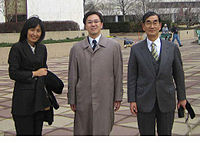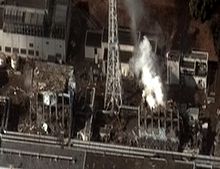- Japanese Nuclear Safety Commission
-
Japan's Nuclear Safety Commission (原子力安全委員会 Genshiryoku Anzen Iinkai) is a commission established within the Cabinet of Japan as an independent agency to play the main role in nuclear safety administration. Commissioners are appointed by the Prime Minister of Japan on Diet approval. The commission has stronger authority than any other ordinary advisory committees, in that the Commission can make recommendations to relevant agencies in the name of the Prime Minister if it is necessary.
The Nuclear Safety Commission reviews safety inspections conducted by regulatory agencies, such as the Nuclear and Industrial Safety Agency.
In 2007 the independence of the Nuclear Safety Commission was questioned by seismologist Professor Katsuhiko Ishibashi, after a senior Nuclear and Industrial Safety Agency official appeared to rule out a new review of the NSC's seismic design standards.[3]
The Asahi newspaper has reported that the government plans to merge the Nuclear and Industrial Safety Agency with the Nuclear Safety Commission, to create a new nuclear safety agency, under the environment ministry, by April 2012.[4]
Contents
History
 The Representatives from the Nuclear Safety Commission visited the NRC headquarters, in order to exchange information with members of the NRC / OIG. (Rockville, Maryland, February 9, 2005)
The Representatives from the Nuclear Safety Commission visited the NRC headquarters, in order to exchange information with members of the NRC / OIG. (Rockville, Maryland, February 9, 2005)
- December 1955 Promulgation of the Atomic Energy Basic Law and Law Establishing the Atomic Energy Commission.
- November 1956 Inauguration of Atomic Energy Commission.
- October 1978 Nuclear Safety Commission spun off from Atomic Energy Commission.
- January 1979 Consistent regulatory administration for nuclear safety introduced and counter- checking system established.
- October 1981 Publication of the 1st White Paper on Nuclear Safety.
- November 1999 Role of Nuclear Safety Commission legally specified with enactment of the Special Measures of Nuclear Disaster Act. Role to include technical advice to Prime Minister in nuclear disaster.
- April 2000 Functions of Commission Secretariat transferred from old Science and Technology Agency to old Prime Minister's Office.
- January 2001 With government reorganization, functions of Nuclear Safety Commission and its Secretariat transferred to Cabinet Office.
- December 2002 Strengthening the functional capability of overlooking and auditing the activities of regulatory body on account of the amendment of the regulation laws on the nuclear reactors, etc.
- July 13, 2011 Japanese Nuclear Safety Commission made official announcement at last the report dated June 11, 1993 (Heisei 5) titled lit. The event of entire alternating current station blackout on the nuclear power plant (原子力発電所における全交流電源喪失事象について) conducted by a working group. This is reporting the evaluation of the regulations against the possible occurrence of the entire loss or station blackout (SBO) of alternating current in nuclear power plants in other countries and Japan, and it resulted the necessities of further discussions on the methodology to avoid or recover the SBO, and it reported the probability of SBO in Japan is less than other countries on its reliability.[5][6]
- On August 26 2011, the Office for the Preparation of Nuclear Safety Regulatory Organization Reform was established at Japan’s Cabinet Secretariat in Nagatacho, Tokyo. Later that day a celebration was held in Kasumigaseki. This reform was to split the promotion of nuclear power from the control-function. The task of the new office was to make preparations to realize the new control-body under the Ministry of Environment (MOE) in April 2012 including the necessary legislation for this. The office would be manned with 37 staff members from the Cabinet Office, the Ministry of Education, Culture, Sports, Science and Technology (MEXT), the Ministry of Economy, Trade and Industry (METI), and other ministries and agencies, and some delegations from private companies. [7]
See also
- Nuclear Safety
- Nuclear Power in Japan
- 2011 Japanese nuclear accidents
- Fukushima Daiichi nuclear disaster
- Japanese reaction to Fukushima Daiichi nuclear disaster
- Japanese nuclear incidents
External links
References
- ^ Tomoko Yamazaki and Shunichi Ozasa (June 27, 2011). "Fukushima Retiree Leads Anti-Nuclear Shareholders at Tepco Annual Meeting". Bloomberg. http://www.bloomberg.com/news/2011-06-26/fukushima-retiree-to-lead-anti-nuclear-motion.html.
- ^ Mari Saito (May 7, 2011). "Japan anti-nuclear protesters rally after PM call to close plant". Reuters. http://www.reuters.com/article/2011/05/07/us-japan-nuclear-idUSTRE74610J20110507.
- ^ Katsuhiko Ishibashi, "Why worry? Japan's nuclear plants at grave risk from quake damage" The Asia-Pacific Journal: Japan Focus (August 11, 2007) Also published by the International Herald Tribune (August 11, 2007). Retrieved March 24, 2011
- ^ Tsuyoshi Inajima (August 3, 2011). "Japan May Create New Nuclear Watchdog by April, Asahi Reports". Bloomberg. http://www.bloomberg.com/news/2011-08-03/japan-may-create-new-nuclear-watchdog-by-april-asahi-reports.html.
- ^ "原子力発電所における全交流電源喪失事象について [The event of entire Alternating Current station blackout on the nuclear power plant]" (in Japanese). Japanese Nuclear Safety Commission. dated 1993-06-11. Archived from the original on 2011-07-13. http://www.nsc.go.jp/info/20110713_dis.pdf. Retrieved 2011-07-18.
- ^ 1. "18年前、全電源喪失検討 安全委 幻の報告書 [18 years ago, SBO was discussed by Japanese Nuclear Safety Commission, but it is a phantom report.]" (in Japanese). Tokyo Shimbun. 2011-07-14 ver.11 Page 2. http://www.tokyo-np.co.jp/s/article/2011071390070408.html. Retrieved 2011-07-18.
2. "東日本大震災:福島第1原発事故「全電源喪失は考慮不要」93年、安全委が国追認 [Aftermath of the 2011 Tōhoku earthquake and tsunami; Fukushima Daiichi nuclear disaster, "reported in 1993, No need to consider SBO", Japanese Nuclear Safety Commission had followed to acknowledge governments regulation.]" (in Japanese). Mainichi Shimbun. 2011-07-14 ver.14新Page 1. http://mainichi.jp/select/weathernews/news/20110714ddm001040054000c.html. Retrieved 2011-07-18.
3. "18年前に電源喪失対策検討「重大性低い」安全委結論 [Japanese Nuclear Safety Commission concluded "Low seriousness" on discussed SBO 18 years ago.]" (in Japanese). Asahi Shimbun. 2011-07-14 Ver. 13 Page 1. http://www.asahi.com/national/update/0713/TKY201107130644.html. Retrieved 2011-07-18.
4. "原発の電源喪失、安全委93年に検討…公表せず [SBO in nuclear power plant, Japanese Nuclear Safety Commission discussed in 1993, ..... but no disclosure.]" (in Japanese). 2011-07-15. http://www.yomiuri.co.jp/science/news/20110716-OYT1T00168.htm. Retrieved 2011-07-18. - ^ Jaif (5 September 2011)Japan’s Cabinet Secretariat Sets Up Office for Nuclear Safety Regulatory Reform
Nuclear power in Japan Active LWR plants Other plants Kaminoseki · Maki · Monju · Namie-Odaka · Ōma · Fugen (ATR) (inactive) · Jōyō (FBR) · Rokkasho (reprocessing)Fukushima Daiichi nuclear disaster Cleanup · Timeline · Radiation effects · Japanese reaction · International reaction · Reactor units 4, 5 and 6Companies Chugoku Electric Power Company · Japan Nuclear Fuel Limited · Mitsubishi FBR Systems · Tokyo Electric Power CompanyOrganisations Atomic Energy Commission · Japan Atomic Energy Agency · Japan Electric Association · Nuclear Safety Commission · Nuclear and Industrial Safety AgencyAnti-nuclear movement Anti-nuclear protests · Citizen's Nuclear Information Center · Tetsunari Iida · Haruki Murakami · Kenzaburo Oe · Ryuichi SakamotoMiscellaneous 2011 Japanese nuclear accidents · Iwaishima · Japanese nuclear incidents · Radiation Monitoring · Genpatsu-shinsaiCategories:- Nuclear regulatory organizations
- Nuclear technology organizations of Japan
- Japan organization stubs
Wikimedia Foundation. 2010.

